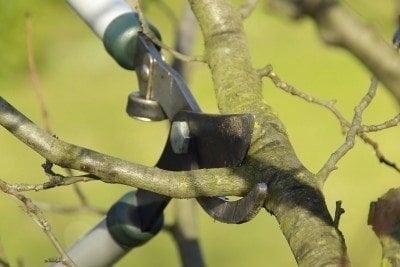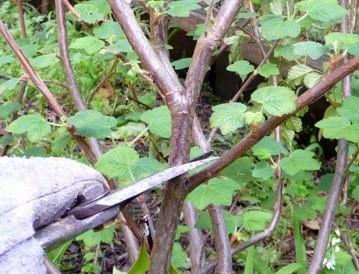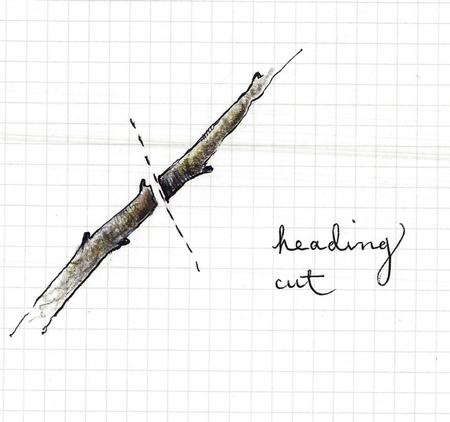Winter Pruning of Deciduous Shrubs and Trees
-
It’s That Time Again! Winter Pruning of Deciduous Shrubs and Trees...
Whether you are an experienced or novice pruner, this short summary of why, when, and how to prune deciduous shrubs and trees during the dormant season is intended to be a useful reminder or a helpful primer.
Why Prune?
Pruning serves many aesthetic and practical objectives. It can help to (1) increase the yield of flowers and fruit; (2) increase plant vigor; (3) control plant size; (4) create privacy; (5) shape a plant for a particular look or location; and (6) repair or rejuvenate a plant.When to Prune?
Winter pruning spans the dormant period – after leaf drop and before new buds start to break. During this period, most sugars are stored in plant roots, not in the branches that you prune. As a result, new growth in the spring typically is very vigorous, because the stored sugar is intended for a larger structure than will remain after pruning.What Plants to Prune?
As a general rule, all deciduous trees and shrubs may be pruned during the winter dormant period. However, there are exceptions. For example, apricots and cherries are susceptible to water-borne diseases and are best pruned in the late summer, during an extended period of dry weather, and no later than October 1. This allows the pruning cuts to begin to seal before the rains begin.How to Prune?
Tools
The best pruning tools for the home gardener are bypass shears and a small fruit saw. Bypass shears are like scissors – the blades pass across each other. Keep them sharp and clean. A fruit saw is useful for all cuts larger than those that bypass shears can remove with moderate pressure from one hand – to avoid ligament and tendon damage. It is good practice to learn to swap your shears and saw interchangeably, as each branch requires. (Note: Anvil shears and loppers do not make fine cuts and are not recommended. Pole bypass pruners can be effective, if you can see and control your cut.)Types of Cuts
There are three basic pruning cuts.- Thinning: A thinning cut removes an entire branch at its point of origin, just beyond its branch collar. Flush cuts remove the specialized cells in the branch collar that seal the wound.

- Releadering: A releadering cut removes a dominant branch adjacent to a subordinate branch (often at a multi-branch union), allowing the subordinate branch to become the leader. There is no branch collar at this union. As a general rule, make sure that the subordinate branch is at least one-third the size of the leader you remove and try to leave a stub of no more than 1/8 to ¼ inch.

- Heading: A heading cut removes only a portion of a branch, generally the tip and the next few buds. Cut about 1/4 inch above a bud, and focus on the direction of the bud you choose, because the new branch will grow in that direction. Use heading cuts sparingly. They may seal poorly and become a disease portal, and they are more likely to spawn a chaotic profusion of new branches called “witch’s broom.”

What to Cut
Before you begin, walk around the plant, get inside it to see its structure, step back to see how it fits into the landscape and make a plan to achieve one or more of the objectives referenced in “Why Prune?” above. Every cut should serve that plan.The Four Ds
Consider removing four types of branches at the outset – those that are dead, diseased, damaged, or dysfunctional. Examples of dysfunctional branches include those that are competing, crossing, or crowded.Plants that Grow from Canes
Cane plants grow in the form of shoots or branches that emerge directly from the root stock – for example, Buddleia (butterfly bush). Some cane plants can be completely coppiced (beheaded) down to their root stocks and will generate healthy new growth in the spring. As a less drastic alternative, all cane plants can be pruned by removing some older entire canes each year to make room for new canes, allowing the plant to continually refresh itself.Plants that Branch
Plants that branch generally require cuts that increase the flow of sunlight and air into and across the plant. Sunlight should be able to penetrate the center to reach leaves, flowers, and fruit. Air flow should be sufficient to “allow a bird to fly through it”– albeit a very small and skillful one.Central Leader or Vase?
Growers of fruit trees debate whether to allow for a central leader or to create a vase-shaped plant. However, if you plan to keep your tree to about 6 feet, it makes no difference. Either shape will produce comparable amounts of fruit.Fruit Spurs
Those scrawny, contorted branches on most fruit trees may be the fruiting spurs. Unless they are too tightly spaced or not located where sun and air will penetrate, do not remove them.Water Spouts and Suckers
Water spouts are branches that grow vertically or nearly vertically from their host branches. With rare exception, they should be removed, because they sap the strength of the plant and are weakly attached (making them generally poor choices for scaffold branches in future years).Suckers are branches that grow directly from the root stock and also should be removed. If they are small, they may be torn from the root stock by hand to remove the bud structure from which they emerge.
New Wood/Old Wood
Some plants bloom on new wood – the wood that first emerges with the spring growth (eg., Lagerstroemia (crape myrtle) and Cotinus (smoke tree). Some plants bloom on old wood – the wood that emerged in an earlier year and is present at the start of the dormant season (eg., Azaleas and Camelias). Still others bloom intermittently on new and old wood (eg., Arbutus unedo (strawberry tree and most citrus). Know the new wood/old wood characteristics of your plants. If you prune all of the branches of a plant that blooms on old wood, you may get a lot of leaves, but no blossoms or fruit.How Much to Remove
As a rule of thumb, remove no more than one-third of a fruit tree or shrub – or more than 25 percent of a non-fruiting tree or shrub. Removing more of the plant risks sending it into shock or promoting overly vigorous growth that can defeat the purpose of pruning. Removing less may be required if the plant is old or diseased and, therefore, less vigorous. If your goal is to severely reshape or restructure a plant, consider implementing your plan over two or three years.Pruning can seem daunting at first, but once you learn the basic approach and cuts, it is very rewarding.
Note: The UC Marin Master Gardener Pruning Guild offers public pruning talks from January through June.
By UC Marin Master Gardener Kirby Wilcox



